The Link between Surface Visible Light Spectral Features and Water–Salt Transfer in Saline Soils—Investigation Based on Soil Column Laboratory Experiments
Abstract
1. Introduction
2. Materials and Methods
2.1. Design of the Experimental Setup for the Indoor Soil Column Experiment
2.2. Multispectral Camera Data Processing
2.3. Calculation of the Salinity Spectral Index
3. Results
3.1. Variation in Band Reflectance on the Surface of Soil Column
3.2. Characteristics of Water Content Change in Soil Column Layers
3.3. Characteristics of Conductivity Change in Soil Column Layers
3.4. Temperature Changes in Soil Column Layers
3.5. Characteristics of Changes in the Surface Salinity Index of Soil Columns
3.6. Accumulation of Mass Loss in the Soil Column during the Experiment
4. Discussion
4.1. Changes in Soil Spectral Reflectance
4.2. Relationship between Soil Column Water and Salt Transport Laws and Surface Soil Spectral Indices
4.3. Limitations and Future
5. Conclusions
Supplementary Materials
Author Contributions
Funding
Data Availability Statement
Acknowledgments
Conflicts of Interest
References
- Wu, H.; Guo, B.; Fan, J.; Yang, F.; Han, B.; Wei, C.; Lu, Y.; Zang, W.; Zhen, X.; Meng, C. A novel remote sensing ecological vulnerability index on large scale: A case study of the China-Pakistan Economic Corridor region. Ecol. Indic. 2021, 129, 107955. [Google Scholar] [CrossRef]
- Vineis, P.; Khan, A. Climate Change–Induced Salinity Threatens Health. Science 2012, 338, 1028–1029. [Google Scholar] [CrossRef] [PubMed]
- Prăvălie, R. Exploring the multiple land degradation pathways across the planet. Earth-Sci. Rev. 2021, 220, 103689. [Google Scholar] [CrossRef]
- Sahab, S.; Suhani, I.; Srivastava, V.; Chauhan, P.S.; Singh, R.P.; Prasad, V. Potential risk assessment of soil salinity to agroecosystem sustainability: Current status and management strategies. Sci. Total Environ. 2021, 764, 144164. [Google Scholar] [CrossRef]
- McNeill, J.R.; Winiwarter, V. Breaking the Sod: Humankind, History, and Soil. Science 2004, 304, 1627–1629. [Google Scholar] [CrossRef] [PubMed]
- Godfray, H.C.J.; Beddington, J.R.; Crute, I.R.; Haddad, L.; Lawrence, D.; Muir, J.F.; Pretty, J.; Robinson, S.; Thomas, S.M.; Toulmin, C. Food Security: The Challenge of Feeding 9 Billion People. Science 2010, 327, 812–818. [Google Scholar] [CrossRef]
- Zhao, Q.; Bai, J.; Zhang, G.; Jia, J.; Wang, W.; Wang, X. Effects of water and salinity regulation measures on soil carbon sequestration in coastal wetlands of the Yellow River Delta. Geoderma 2018, 319, 219–229. [Google Scholar] [CrossRef]
- Aimen, A.; Kuandykova, G.; Suleimenova, I.; Tashmukhamedov, F.; Demeuova, G.; Anarova, G.; Aimenova, S.; Moldasheva, A.J.I.J.O.E.; Sciences, E. Environmental evaluation of water salt exchange process in soil degradation in the arid zone. Int. J. Ecosyst. Ecol. Sci. 2022, 12, 33. [Google Scholar] [CrossRef]
- Daliakopoulos, I.N.; Tsanis, I.K.; Koutroulis, A.; Kourgialas, N.N.; Varouchakis, A.E.; Karatzas, G.P.; Ritsema, C.J. The threat of soil salinity: A European scale review. Sci. Total Environ. 2016, 573, 727–739. [Google Scholar] [CrossRef]
- Abrol, I.; Yadav, J.S.P.; Massoud, F. Salt-Affected Soils and Their Management; Food & Agriculture Organization: Rome, Italy, 1988; Volume 39. [Google Scholar]
- Wu, W.; Al-Shafie, W.M.; Mhaimeed, A.S.; Ziadat, F.; Nangia, V.; Payne, W.B. Soil Salinity Mapping by Multiscale Remote Sensing in Mesopotamia, Iraq. IEEE J. Sel. Top. Appl. Earth Obs. Remote Sens. 2014, 7, 4442–4452. [Google Scholar] [CrossRef]
- Hassani, A.; Azapagic, A.; Shokri, N. Global predictions of primary soil salinization under changing climate in the 21st century. Nat. Commun. 2021, 12, 6663. [Google Scholar] [CrossRef] [PubMed]
- Lhissoui, R.; Harti, A.E.; Chokmani, K. Mapping soil salinity in irrigated land using optical remote sensing data. Eurasian J. Soil Sci. 2014, 3, 82–88. [Google Scholar] [CrossRef]
- Chaaou, A.; Chikhaoui, M.; Naimi, M.; Miad, A.K.E.; Bokoye, A.I.; Ennasr, M.S.; Harche, S.E. Potential of land degradation index for soil salinity mapping in irrigated agricultural land in a semi-arid region using Landsat-OLI and Sentinel-MSI data. Environ. Monit. Assess. 2024, 196, 843. [Google Scholar] [CrossRef] [PubMed]
- Metternicht, G.I.; Zinck, J.A. Remote sensing of soil salinity: Potentials and constraints. Remote Sens. Environ. 2003, 85, 1–20. [Google Scholar] [CrossRef]
- Sahbeni, G.; Ngabire, M.; Musyimi, P.K.; Székely, B. Challenges and Opportunities in Remote Sensing for Soil Salinization Mapping and Monitoring: A Review. Remote Sens. 2023, 15, 2540. [Google Scholar] [CrossRef]
- Guo, B.; Zang, W.; Luo, W.; Wen, Y.; Yang, F.; Han, B.; Fan, Y.; Chen, X.; Qi, Z.; Wang, Z.; et al. Detection model of soil salinization information in the Yellow River Delta based on feature space models with typical surface parameters derived from Landsat8 OLI image. Geomat. Nat. Hazards Risk 2020, 11, 288–300. [Google Scholar] [CrossRef]
- Miller, B.A.; Lee Burras, C. Comparison of Surficial Geology Maps Based on Soil Survey and in Depth Geological Survey. Soil Horiz. 2015, 56, 1–12. [Google Scholar] [CrossRef]
- Ben-Dor, E.; Chabrillat, S.; Demattê, J.A.M.; Taylor, G.R.; Hill, J.; Whiting, M.L.; Sommer, S. Using Imaging Spectroscopy to study soil properties. Remote Sens. Environ. 2009, 113, S38–S55. [Google Scholar] [CrossRef]
- Farifteh, J.; Farshad, A.; George, R.J. Assessing salt-affected soils using remote sensing, solute modelling, and geophysics. Geoderma 2006, 130, 191–206. [Google Scholar] [CrossRef]
- Han, M.; Zhao, C.; Šimůnek, J.; Feng, G. Evaluating the impact of groundwater on cotton growth and root zone water balance using Hydrus-1D coupled with a crop growth model. Agric. Water Manag. 2015, 160, 64–75. [Google Scholar] [CrossRef]
- Yang, T.; Šimůnek, J.; Mo, M.; McCullough-Sanden, B.; Shahrokhnia, H.; Cherchian, S.; Wu, L. Assessing salinity leaching efficiency in three soils by the HYDRUS-1D and -2D simulations. Soil Tillage Res. 2019, 194, 104342. [Google Scholar] [CrossRef]
- Ramos, T.B.; Darouich, H.; Oliveira, A.R.; Farzamian, M.; Monteiro, T.; Castanheira, N.; Paz, A.; Alexandre, C.; Gonçalves, M.C.; Pereira, L.S. Water use, soil water balance and soil salinization risks of Mediterranean tree orchards in southern Portugal under current climate variability: Issues for salinity control and irrigation management. Agric. Water Manag. 2023, 283, 108319. [Google Scholar] [CrossRef]
- Han, L.; Ding, J.; Ge, X.; He, B.; Wang, J.; Xie, B.; Zhang, Z. Using spatiotemporal fusion algorithms to fill in potentially absent satellite images for calculating soil salinity: A feasibility study. Int. J. Appl. Earth Obs. Geoinf. 2022, 111, 102839. [Google Scholar] [CrossRef]
- Shokri-Kuehni, S.M.S.; Norouzi Rad, M.; Webb, C.; Shokri, N. Impact of type of salt and ambient conditions on saline water evaporation from porous media. Adv. Water Resour. 2017, 105, 154–161. [Google Scholar] [CrossRef]
- Xu, L.; Wang, Z.-c.; Nyongesah, J.M. Soil Column Sample Height Influences Soil Spectral Reflectance in Laboratory Experiment. J. Indian Soc. Remote Sens. 2019, 47, 1187–1196. [Google Scholar] [CrossRef]
- Shi, T.; Cui, L.; Wang, J.; Fei, T.; Chen, Y.; Wu, G. Comparison of multivariate methods for estimating soil total nitrogen with visible/near-infrared spectroscopy. Plant Soil 2013, 366, 363–375. [Google Scholar] [CrossRef]
- Jhan, J.-P.; Rau, J.-Y.; Huang, C.-Y. Band-to-band registration and ortho-rectification of multilens/multispectral imagery: A case study of MiniMCA-12 acquired by a fixed-wing UAS. ISPRS J. Photogramm. Remote Sens. 2016, 114, 66–77. [Google Scholar] [CrossRef]
- Jhan, J.-P.; Rau, J.-Y.; Haala, N. Robust and adaptive band-to-band image transform of UAS miniature multi-lens multispectral camera. ISPRS J. Photogramm. Remote Sens. 2018, 137, 47–60. [Google Scholar] [CrossRef]
- Deering, D.; Haas, R. Using Landsat digital data for estimating green biomass. In Proceedings of the Ann. Meeting of the Soc. for Range Management Symp. on Rangeland Remote Sensing, Portland, OR, USA, 17 February 1980; Available online: http://ntrs.nasa.gov/archive/nasa/casi.ntrs.nasa.gov/19800024311.pdf (accessed on 25 January 2015).
- Khan, N.M.; Rastoskuev, V.V.; Sato, Y.; Shiozawa, S. Assessment of hydrosaline land degradation by using a simple approach of remote sensing indicators. Agric. Water Manag. 2005, 77, 96–109. [Google Scholar] [CrossRef]
- Douaoui, A.E.K.; Nicolas, H.; Walter, C. Detecting salinity hazards within a semiarid context by means of combining soil and remote-sensing data. Geoderma 2006, 134, 217–230. [Google Scholar] [CrossRef]
- Abbas, A.; Khan, S. Using remote sensing techniques for appraisal of irrigated soil salinity. In Proceedings of the International Congress on Modelling and Simulation (MODSIM), Christchurch, New Zealand, 10–13 December 2007; Modelling and Simulation Society of Australia and New Zealand: Canberra, Australia, 2007; pp. 2632–2638. [Google Scholar]
- Allbed, A.; Kumar, L.; Aldakheel, Y.Y. Assessing soil salinity using soil salinity and vegetation indices derived from IKONOS high-spatial resolution imageries: Applications in a date palm dominated region. Geoderma 2014, 230–231, 1–8. [Google Scholar] [CrossRef]
- Fan, X.; Liu, Y.; Tao, J.; Weng, Y. Soil Salinity Retrieval from Advanced Multi-Spectral Sensor with Partial Least Square Regression. Remote Sens. 2015, 7, 488–511. [Google Scholar] [CrossRef]
- Abuelgasim, A.; Ammad, R. Mapping soil salinity in arid and semi-arid regions using Landsat 8 OLI satellite data. Remote Sens. Appl. Soc. Environ. 2019, 13, 415–425. [Google Scholar] [CrossRef]
- Masoud, A.A. Predicting salt abundance in slightly saline soils from Landsat ETM+ imagery using Spectral Mixture Analysis and soil spectrometry. Geoderma 2014, 217–218, 45–56. [Google Scholar] [CrossRef]
- Xing, X.; Li, X.; Ma, X. Capillary rise and saliferous groundwater evaporation: Effects of various solutes and concentrations. Hydrol. Res. 2019, 50, 517–525. [Google Scholar] [CrossRef]
- Hu, S.; Zhang, C.; Lu, N. Quantifying Coupling Effects between Soil Matric Potential and Osmotic Potential. Water Resour. Res. 2023, 59, e2022WR033779. [Google Scholar] [CrossRef]
- Qin, S.; Ding, J.; Ge, X.; Wang, J.; Wang, R.; Zou, J.; Tan, J.; Han, L. Spatio-Temporal Changes in Water Use Efficiency and Its Driving Factors in Central Asia (2001–2021). Remote Sens. 2023, 15, 767. [Google Scholar] [CrossRef]
- Farifteh, J.; van der Meer, F.; van der Meijde, M.; Atzberger, C. Spectral characteristics of salt-affected soils: A laboratory experiment. Geoderma 2008, 145, 196–206. [Google Scholar] [CrossRef]
- Farifteh, J.; van der Meer, F.; Carranza, E.J.M. Similarity measures for spectral discrimination of salt-affected soils. Int. J. Remote Sens. 2007, 28, 5273–5293. [Google Scholar] [CrossRef]
- Eshel, G.; Levy, G.J.; Singer, M.J. Spectral Reflectance Properties of Crusted Soils under Solar Illumination. Soil Sci. Soc. Am. J. 2004, 68, 1982–1991. [Google Scholar] [CrossRef]
- Liu, Y.; Pan, X.; Wang, C.; Li, Y.; Shi, R. Can subsurface soil salinity be predicted from surface spectral information?—From the perspective of structural equation modelling. Biosyst. Eng. 2016, 152, 138–147. [Google Scholar] [CrossRef]
- Han, L.; Ding, J.; Zhang, J.; Chen, P.; Wang, J.; Wang, Y.; Wang, J.; Ge, X.; Zhang, Z. Precipitation events determine the spatiotemporal distribution of playa surface salinity in arid regions: Evidence from satellite data fused via the enhanced spatial and temporal adaptive reflectance fusion model. Catena 2021, 206, 105546. [Google Scholar] [CrossRef]
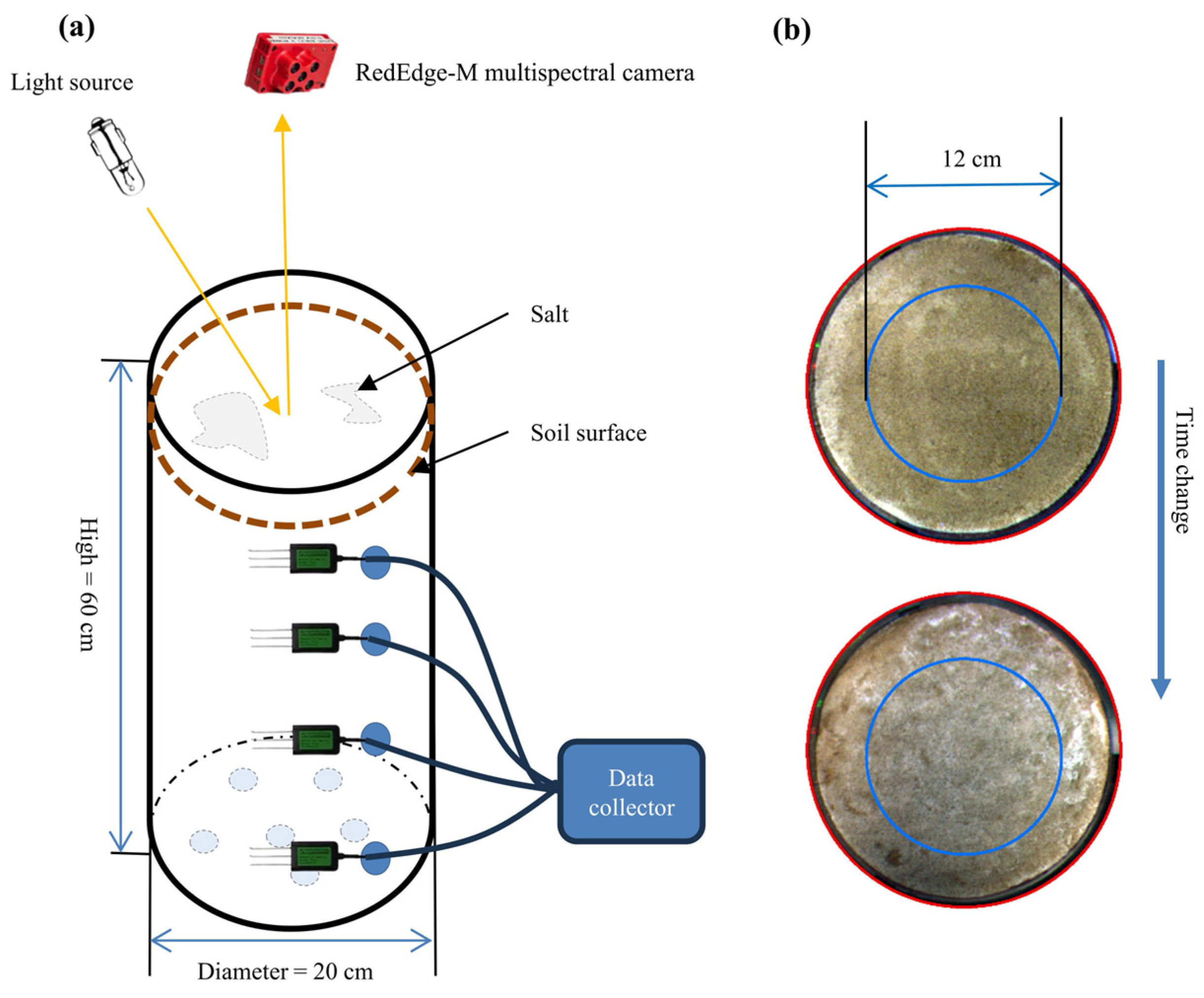
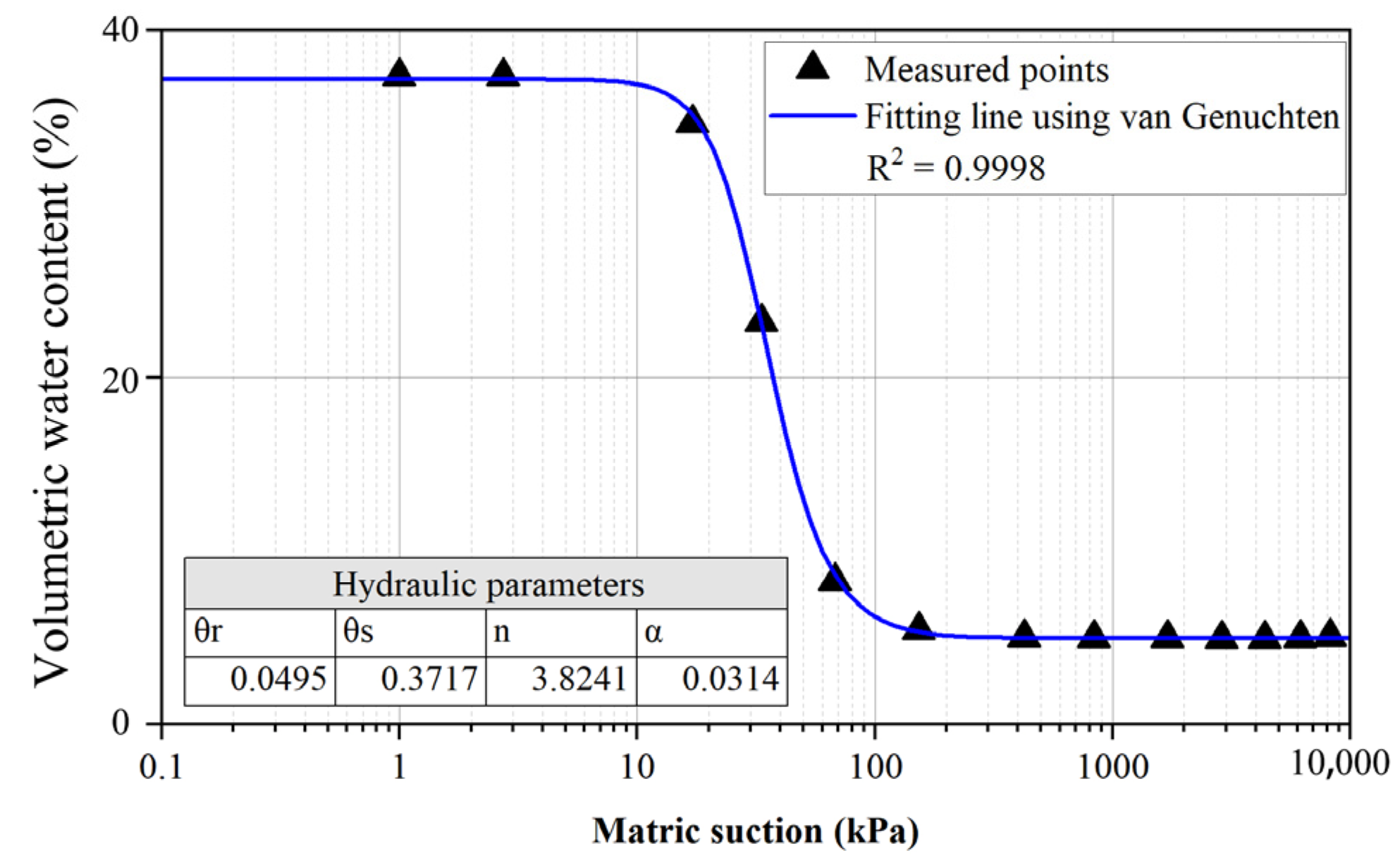



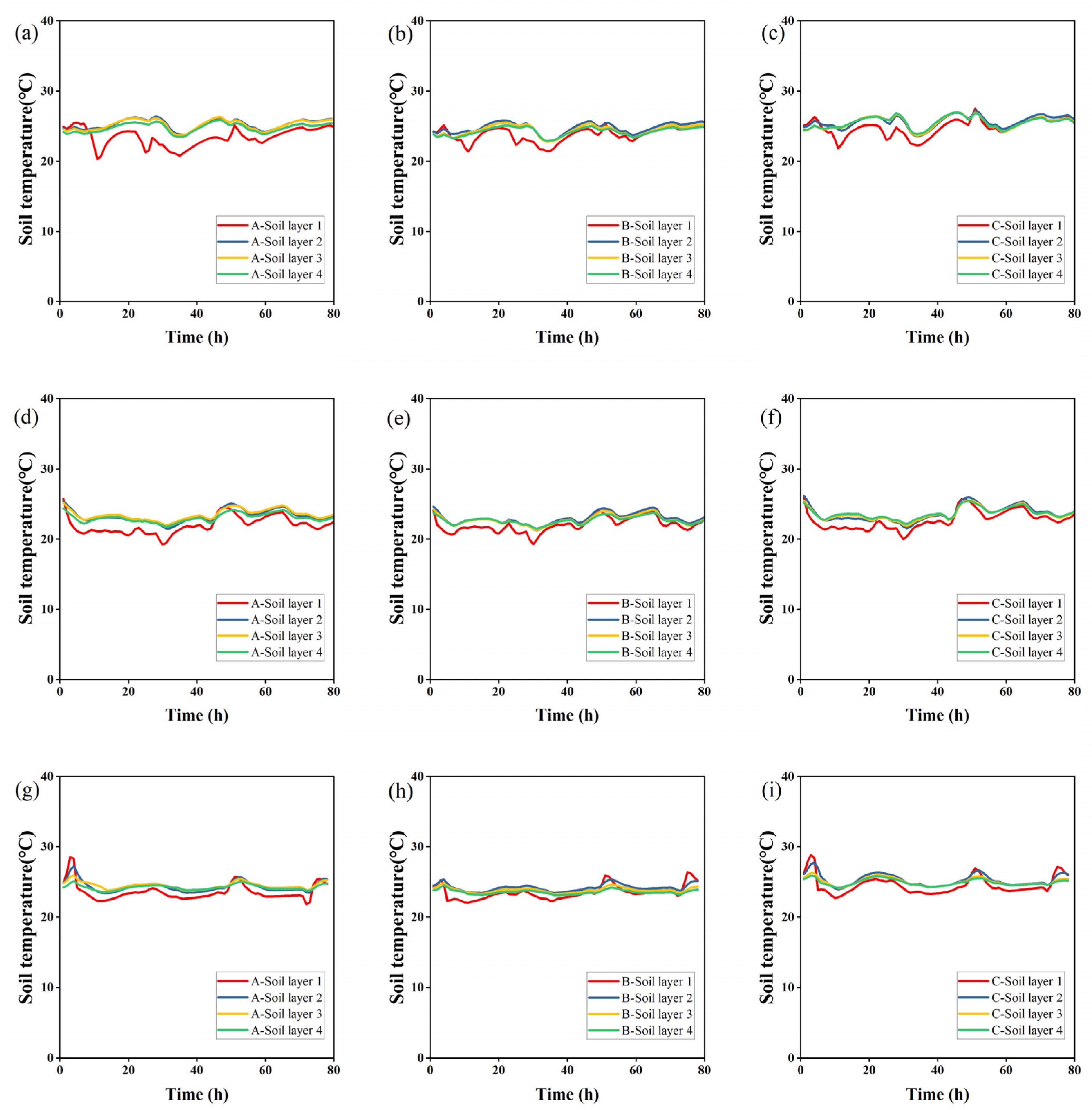

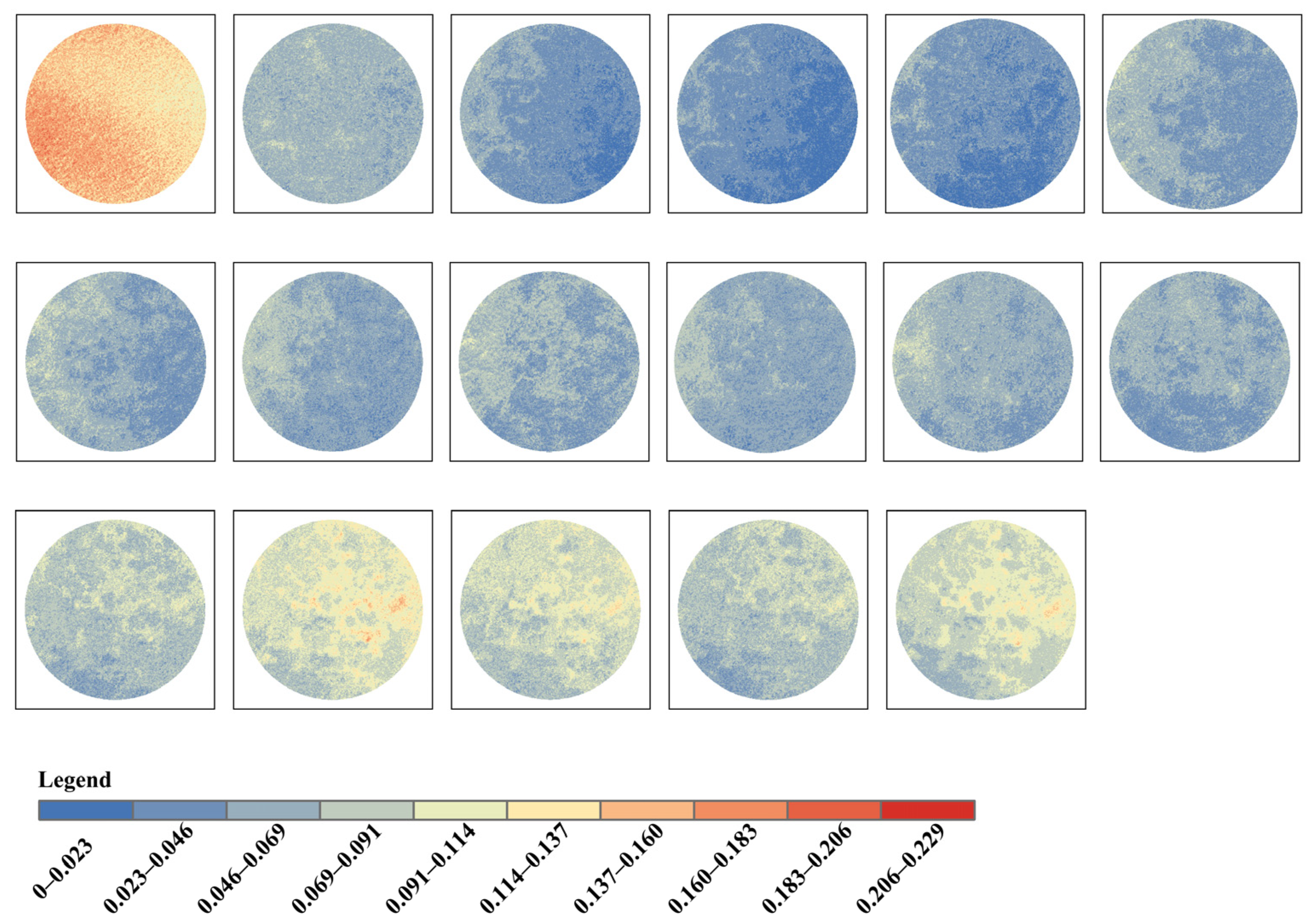
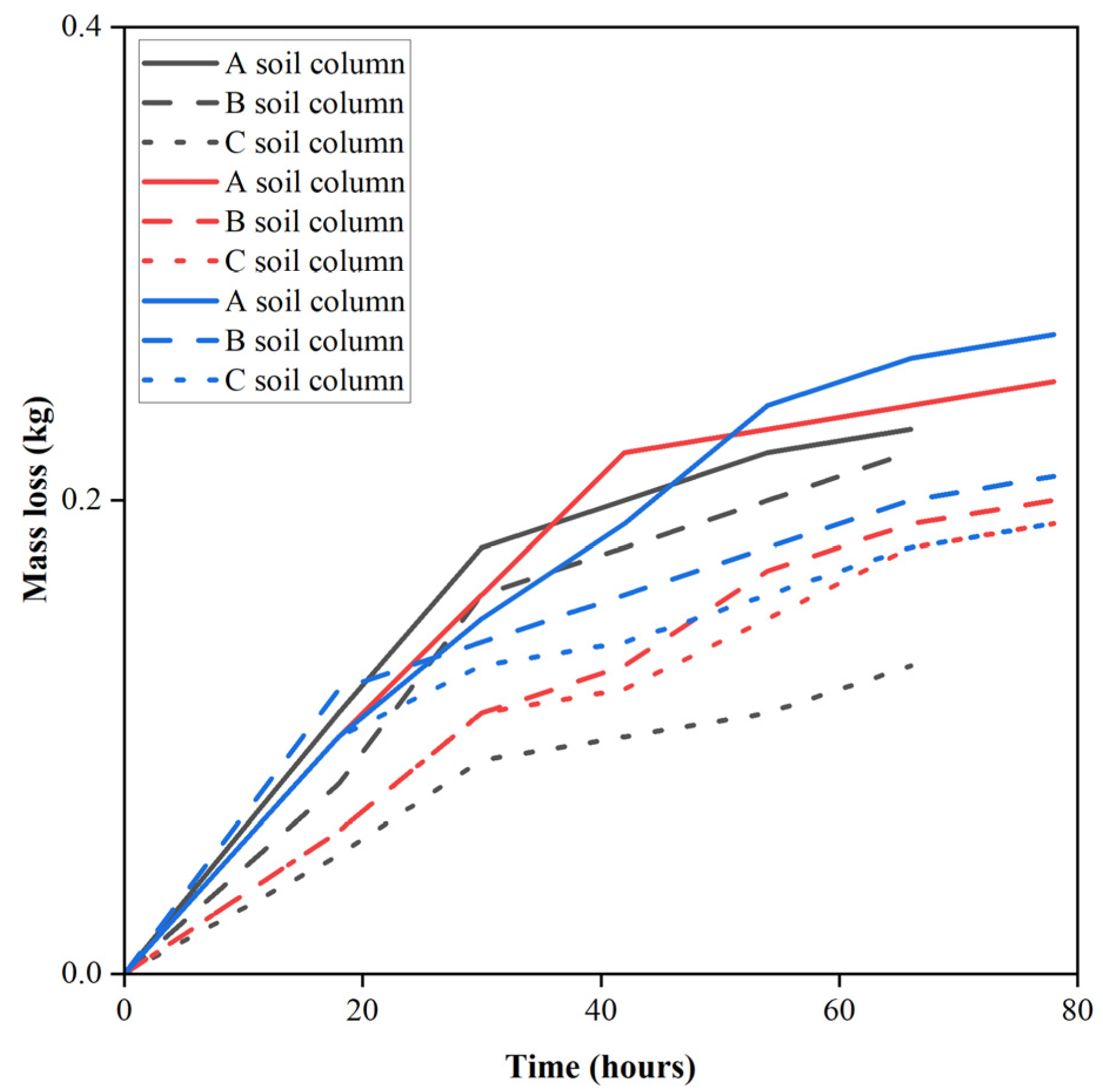
| Soil Column | Layer Name | Initial Water Content (%) | Initial Salinity (μS/cm) |
|---|---|---|---|
| Soil column A | Soil layer-1 | 1.704 | 0.000 |
| Soil layer-2 | 1.280 | 0.000 | |
| Soil layer-3 | 2.093 | 0.000 | |
| Soil layer-4 | 1.160 | 0.000 | |
| Soil column B | Soil layer-1 | 9.020 | 260.000 |
| Soil layer-2 | 6.660 | 268.150 | |
| Soil layer-3 | 2.800 | 143.000 | |
| Soil layer-4 | 1.704 | 1.000 | |
| Soil column C | Soil layer-1 | 16.675 | 647.250 |
| Soil layer-2 | 11.255 | 390.750 | |
| Soil layer-3 | 11.730 | 486.250 | |
| Soil layer-4 | 15.490 | 561.500 |
| Soil Type | Upper Cumulative Results (2 μm) | Results in the Interval (2, 50 μm) | Results in the Interval (50, 2000 μm) | Bottom Cumulative Result (2000 μm) | Specific Surface Area Result |
|---|---|---|---|---|---|
| 0.47 | 4.38 | 95.15 | 1 × 10−11 | 37.67 |
| Band Number | Band Name | Center Wavelength (nm) | Bandwidth (nm) |
|---|---|---|---|
| Band 1 | Blue band | 475 | 20 |
| Band 2 | Green band | 560 | 20 |
| Band 3 | Red band | 668 | 10 |
| Band 4 | Near-infrared band | 840 | 40 |
| Band 5 | RedEdge band | 717 | 10 |
| Index Names | Calculation Equation | Reference |
|---|---|---|
| NDVI | [30] | |
| SI | [31] | |
| SI1 | ||
| SI2 | [32] | |
| SI3 | ||
| S1 | ||
| S2 | [33] | |
| S3 | ||
| S4 | ||
| S5 | [34] | |
| S6 |
| Salinity Index | R2 | RMSE |
|---|---|---|
| NDVI | 0.274 | 0.019 |
| S1 | 0.451 | 0.010 |
| S2 | 0.469 | 0.017 |
| S3 | 0.624 | 0.123 |
| S4 | 0.726 | 0.011 |
| S5 | 0.734 | 0.009 |
| S6 | 0.704 | 0.115 |
| SI | 0.719 | 0.020 |
| SI1 | 0.730 | 0.057 |
| SI2 | 0.729 | 0.032 |
| SI3 | 0.702 | 0.038 |
Disclaimer/Publisher’s Note: The statements, opinions and data contained in all publications are solely those of the individual author(s) and contributor(s) and not of MDPI and/or the editor(s). MDPI and/or the editor(s) disclaim responsibility for any injury to people or property resulting from any ideas, methods, instructions or products referred to in the content. |
© 2024 by the authors. Licensee MDPI, Basel, Switzerland. This article is an open access article distributed under the terms and conditions of the Creative Commons Attribution (CC BY) license (https://creativecommons.org/licenses/by/4.0/).
Share and Cite
Qin, S.; Zhang, Y.; Ding, J.; Wang, J.; Han, L.; Zhao, S.; Zhu, C. The Link between Surface Visible Light Spectral Features and Water–Salt Transfer in Saline Soils—Investigation Based on Soil Column Laboratory Experiments. Remote Sens. 2024, 16, 3421. https://doi.org/10.3390/rs16183421
Qin S, Zhang Y, Ding J, Wang J, Han L, Zhao S, Zhu C. The Link between Surface Visible Light Spectral Features and Water–Salt Transfer in Saline Soils—Investigation Based on Soil Column Laboratory Experiments. Remote Sensing. 2024; 16(18):3421. https://doi.org/10.3390/rs16183421
Chicago/Turabian StyleQin, Shaofeng, Yong Zhang, Jianli Ding, Jinjie Wang, Lijing Han, Shuang Zhao, and Chuanmei Zhu. 2024. "The Link between Surface Visible Light Spectral Features and Water–Salt Transfer in Saline Soils—Investigation Based on Soil Column Laboratory Experiments" Remote Sensing 16, no. 18: 3421. https://doi.org/10.3390/rs16183421
APA StyleQin, S., Zhang, Y., Ding, J., Wang, J., Han, L., Zhao, S., & Zhu, C. (2024). The Link between Surface Visible Light Spectral Features and Water–Salt Transfer in Saline Soils—Investigation Based on Soil Column Laboratory Experiments. Remote Sensing, 16(18), 3421. https://doi.org/10.3390/rs16183421









